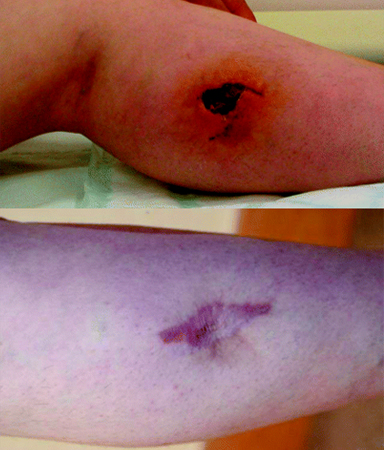Summary
Definition
History and exam
Key diagnostic factors
- presence of risk factors
- circumstances of animal bite
- wound description
- erythema
- induration
- fluctuance
- purulent drainage
- regional adenopathy
- necrotic tissue
- vital signs unstable
Risk factors
- age <14 years
- pet ownership
- high-risk groups (for rabies infection)
- previous medical procedures (increased risk of infection if bitten)
- underlying medical conditions (increased risk of infection if bitten)
Diagnostic investigations
Treatment algorithm
Contributors
Authors
Oliver Spencer, MBBS, BSc, MRCS, FRCEM
Consultant, Emergency Medicine
Croydon University Hospital NHS Trust
London
UK
Disclosures
OS declares that he has no competing interests.
Subhro Banerjee, MBBS, FRCEM
Consultant, Emergency Medicine
Croydon University Hospital
London
UK
Disclosures
SB has no competing interests.
Acknowledgements
Dr Oliver Spencer and Dr Subhro Banerjee would like to gratefully acknowledge Dr A. Parfitt, Dr Randy Taplitz, and Dr Eric Chang, the previous contributors to this topic. AP and EC declare that they have no competing interests. RT has received funding from Pfizer to attend several antifungal symposia and funding from Schering-Plough to attend an antifungal Speaker's Bureau Workshop.
Peer reviewers
Cynthia Christy, MD
Associate Chief of Pediatrics
General Pediatrics/Pediatric Infectious Diseases
University of Rochester
New York
NY
Disclosures
CC declares that she has no competing interests.
Gregory Conners, MD, MPH, MBA, FAAP, FACEP
Interim Chair of Emergency Medicine
Professor of Emergency Medicine and Pediatrics
University of Rochester
New York
NY
Disclosures
GC declares that he has no competing interests.
Jeffrey R. Suchard, MD, FACEP, FACMT
Professor of Clinical Emergency Medicine
Director of Medical Toxicology
Department of Emergency Medicine
University of California
Irvine Medical Center
Orange
CA
Disclosures
JRS declares that he has no competing interests.
Use of this content is subject to our disclaimer
